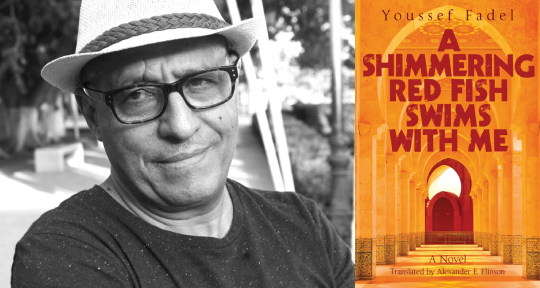A Shimmering Red Fish Swims with Me by Youssef Fadel, translated from the Arabic by Alexander E. Elinson, Hoopoe, 2019
A massive construction project looms in the background of Moroccan author Youssef Fadel’s novel Farah (2016), beautifully translated from the Arabic by Alexander E. Elinson and published under the title A Shimmering Red Fish Swims with Me (Hoopoe 2019). The project in question is the building of Casablanca’s Hassan II Mosque, named after the Moroccan ruler who commissioned it. As Elinson explains in a concise and illuminating foreword to his translation, King Hassan II (r. 1962-1999) announced his plan to build a grand mosque on Casablanca’s Atlantic shoreline during his 1980 birthday celebrations. The mosque was inaugurated in 1993, on the eve of the Prophet Muhammad’s birthday. Designed by a French architect and built by a French firm, the mosque project required the labor of over thirty thousand workers, including thousands of master craftsmen who carved, chiseled, sculpted, and formed its dazzling array of tile mosaics, stucco moldings, and decorative woodwork. The structure that emerged from this massive effort accommodates up to one hundred and five thousand worshippers, making it the largest mosque in Africa and one of the largest mosques in the world—but such grandeur comes at a huge cost, both financial and human. The mosque came with a whopping price tag of over half a billion US dollars, and much of the financial burden fell on Moroccan citizens, who were required to help pay for the mosque through a public subscription program. The project also upended life in Casablanca, particularly for the people who lived in the densely populated neighborhood that was razed to create room for the new mosque.
These upheavals are at the heart of Fadel’s novel, which explores the experiences of the Moroccans who both lived in the shadows of, and contributed to, the construction project, and who were eventually displaced to make room for the massive mosque that they had helped build. A Shimmering Red Fish Swims with Me is Fadel’s tenth novel and the final book in a trilogy about contemporary Morocco. The novel centers on an ill-fated love story between two young Moroccans: Farah, who escapes her hometown of Azemmour and comes to Casablanca to pursue her dream of becoming a singer, and Outhman, who works with his father as a carpenter at the mosque. The lovers’ fate is sealed in the novel’s first chapter, where we learn that Farah is the victim of a brutal acid attack, witnessed by Outhman. The rest of the novel is devoted to unpacking the events leading up to the acid attack on Farah. The story is told through an intricate narrative structure that unfolds along multiple timelines and from multiple perspectives, meting out information in suspenseful portions whose full meanings do not become clear until the last page. Each of the novel’s seven sections opens with a chapter narrated from the perspective of a third-person omniscient narrator located in the present, some twenty-three years after Farah’s death. The internal chapters of each section are narrated in the first person from Outhman’s perspective, beginning at the time he met and fell in love with Farah while working at the mosque’s construction site. The last chapter of each section is narrated in the first person from the perspective of another character in the novel, such as Farah or Outhman’s mother. The result is a kaleidoscopic view of working-class life in Casablanca, one that uses the tragic love story between Farah and Outhman as a launch pad for exploring the tensions running through Moroccan society in the 1980s and ’90s and, in particular, for laying bare the tremendous costs that the Hassan II Mosque inflicted on the people living around it.
READ MORE…



